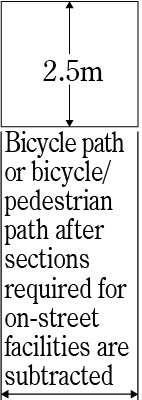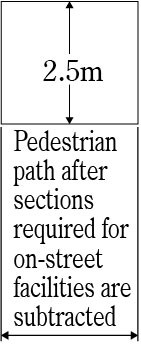Technical standard
ROAD STRUCTURE ORDINANCE
(Government Ordinance No.320 of 29 October, 1970)
(Traffic Safety Device)
Article 31
When it is necessary for traffic accident prevention, the pedestrian bridge, Supporting Infrastructure for automated driving, fence, lighting, safety post, emergency notification facility, and other similar facilities, as specified by the Land, Infrastructure and Transport Ministry's Ordinances, shall be provided.
(Protrusions, Narrow Passes, etc.)
Article 31-2
When it is necessary for slowing down vehicles, to ensure safe pedestrian or bicycle traffic, protrusions shall be provided on the surface of the carriageway or on the shoulders connecting to the carriageway, or narrow passes or bend sections shall be provided on the carriageway, on Type 3 Class 5 roads intended primarily for use by nearby residents.
(Islands Provided at Bus Bays)
Article 31-3
Islands shall be provided as necessary at bus bays or streetcar stops that do not connect to bicycle tracks, bicycle/pedestrian tracks or sidewalks.
(Automobile Parking Lots)
Article 32
Automobile parking lots, bicycle parking lots, bus bays, emergency parking basis or other similar facilities specified by the Land, Infrastructure and Transport Ministry's Ordinances shall be provided, if necessary, to ensure safe and smooth traffic or to contribute to public convenience.
(Snow Protection Facility and Other Protector)
Article 33
1. Where an avalanche, blizzard, snowfall or other meteorological events could prevent smooth traffic, snow shed, drain for snow removal, snow melting facilities or other facilities shall be provided as specified by the Land, Infrastructure and Transport Ministry’ s Ordinances.
2. Unless specified above, a fence, retaining wall, and other proper protectors shall be installed where falling stone, slope failure, billow, etc. could prevent traffic or damage road structure.
(Tunnel)
Article 34
1. To ensure safe and smooth traffic, proper ventilation facilities shall be provided in the tunnel when required in consideration of design daily volume and tunnel length on the road.
2. When required for safe and smooth traffic, proper lighting shall be provided in the tunnel in consideration of design speed.
3. When a vehicle fire or other accidents in the tunnel could cause risks to traffic, the communication facilities, warning facilities, firefighting facilities and other emergency facilities shall be provided in the tunnel if necessary.
(Bridge and Viaducts)
Article 35
1. Bridges, viaducts, or other similar roads shall be steel or concrete structure or the equivalent.
2. Design vehicle load for bridges, viaducts, and other similar regular motor vehicle roads shall be 245kN. The structures of said bridges, viaducts, and other similar regular motor vehicle roads shall secure safe traffic in view of large-sized vehicle traffic conditions for these roads.
3. Design vehicle load for bridges, viaducts, and other similar smaller motor vehicle roads shall be 30kN. The structures of said bridges, viaducts, and other similar smaller motor vehicle roads shall secure safe traffic in view of smaller vehicular traffic conditions for these roads.
4. In addition to the requirements in the three previous paragraphs, necessary matters regarding construction standards for bridges, viaducts, or other similar roads shall be specified by the Ordinances of the Ministry of Land, Infrastructure, Transport and Tourism.
(Exception to Accessory Work)
Article 36
After a case is identified in which road work executed on others roads or work other than road work is executed and determined to be influencing roads, provisions from Articles 4 to 35 (except for Article 8, Article 13, Article 14, Article 24, Article 26, Article 31 and Article 33) may be exempted from application after it is approved that the case is not subject to these requirements.
(Exception to Change of Road Classification)
Article 37
When classification, as specified in Article 3.2, is changed by plans as to change a part of national highways to prefectural or municipal roads, classification following the change shall result in applying requirements of Article 3.4, Article 3.5, Article 4, Article 5, Article 6.1, Article 6.4, Article 6.6, Article 8.2 through 8.6, Article 8.9, Article 8.11, Article 9.1, Article 10.1, Article 10.2, Article 10-2.3, Article 11.1, Article 11.2, Article 11.4, Article 11-4.1, Article 12, Article 13.1, Article 16, Article 17, Article 18.1, Article 20,Article 22.2, Article 23.3, Article 27.3, Article 30 and Article 31-2. In this case, "Type 3 Class 5 roads" in proviso of Article 5.1, Article 5.5, proviso of Article 10.2.3, proviso of Article 11.4 and Article 12 shall be read as "Type 3 Class 5 or Type 4 Class 4 roads". "Type 3 Class 5 roads" in Article 5.3 shall be read as "Type 3 Class 5 and Type 4 Class 4 roads". "Type 4 roads" in Article 9.1 and Article 11.1 shall be read as "Type 4 (except for Class 4)". "Class 3" in Article 10.1 shall be read as "Class 3 and 4". "Type 3" in these paragraphs shall be read as "Type 3 or Type 4 Class 4". "Type 3" in Article 11.1 shall be read as "Type 3 or Type 4 Class 4". "Values listed in the top column" in Article 13.1 shall be read as "Values listed in the top column (for Type 4 Class 4 roads, 40km/h, 30km/h or 20km/h)". "Mainly" in Article 31-2 shall be read as "Type 4 Class 4 roads or mainly".
(Exception to Reconstruction of Short Section)
Article 38
1. When a short section on roads that severely prevents traffic is reconst ructed as an emergency measure, except for reconstruction as listed in the following requirements, this section may be exempted from application of Article 5, Article 6.4 through Article 6.6, Article 7, Article 9, Article 9-2.3, Article 9-3, Article 10.3, Article 10-2.2, Article 10-2.3, Article 11.3, Article 11.4, Article 11-4.2, Article 11-4.3, Article 15 through Article 22, Article 23.3, and Article 25, if it is approved that the road structure of sections adjacent to this section do not satisfy these requirements.
2. When a short section of roads that severely impact safety is reconstructed as an emergency measure, this section shall be exempt from application of Article 5, Article 6.4 through Article 6.6, Article 7, Article 8.2, Article 9, Article 9-2.3,Article 9-3, Article 10.3, Article 10-2.2, Article 10-2.3, Article 11.3, Article 11.4, Article 11-4.2, Article 11-4.3, Article 19.1, Article 21.2, Article 23.3, Article 39.1, Article 39.2, and Article 40.1, if it is determined in consideration of road conditions that it is not proper to apply these requirements.
(Bicycle Path and Bicycle/Pedestrian Path)
Article 39
1. Bicycle path width shal l be not les s than 3m, whi le bicycle/pedestrian path width shall be no less than 4m. However, where topographical conditions or any other reasons do not permit such provisions, bicycle path width can be reduced to 2.5m.
2. Lateral clearances wider than 0.5m shall be provided to both sides of bicycle paths or bicycle/pedestrian paths as a part of the roads.
3. Where on-street facilities are provided on bicycle tracks or bicycle/pedestrian tracks, width of these tracks shall be determined in consideration of clearances as specified in the following provision.
4. Bicycle path and bicycle/pedestrian path clearances shall be in accordance with the following figure.

5. Alignment, grade, and other features of bicycle paths and bicycle/pedestrian paths shall be determined so as to ensure safe and smooth bicycle and pedestrian traffic.
6. Requirements of Article 3 through 37 and Section 1 of the preceding Article (excluding Article 1 1.2 for bicycle/pedestrian path) shall not be applied to bicycle paths and bicycle/pedestrian paths.
(Pedestrian Path)
Article 40
1. Pedestrian path width shall be not less than 2m in consideration of pedestrian traffic conditions and areas where the track is located, except where topographical conditions or other reasons do not permit such provisions, in which case the width can be reduced to 1m.
2. Where on-street facilities are provided on pedestrian paths, width shall be determined in consideration of clearances as specified in the following provision.
3. Pedestrian path clearances shall be in accordance with the following figure.

4. Alignment, grade and other features of pedestrian paths shall be determined so as to ensure safe and smooth pedestrian traffic.
5. Requirements of Articles 3 through 11, Article 11.3 through 37 and Section 1 of Article 38 shall not be applied to pedestrian paths.
(Pedestrian Path)
Article 41
1. Sections for pedestrian stay use shall be provided on sidewalks or bicycle/pedestrian tracks provided to Pedestrian Convenience-Promoting Streets, or bicycle/pedestrian paths that are Pedestrian Convenience-Promoting Streets.
2. Spaces shall be ensured for the sections specified in the preceding paragraph to establish pedestrian convenience-promoting facilities if guidance of appropriate and systematic establishment of pedestrian convenience-promoting facilities is considered necessary. In this case, structures, objects, or facilities that contribute to promoted convenience for pedestrians, such as street lights and benches, shall be established in such spaces if it is considered necessary.
3. Pedestrian convenience-promoting streets (except for newly constructed special roads specified in Article 10.1 of the Act on Promotion of Smooth Transportation, etc. of Elderly Persons, Disabled Persons, etc. (Act No. 91 of 2006)) shall have a structure that complies with the standard for smooth transportation, etc. on roads specified in this paragraph.
(General technical standards for structure of prefectural and municipal roads)
Article 42
1. The provisions of Article 4, 12, 35.2, 35.3, 35.4 (limited to the matters listed in Article 30.1.12), 39.4, and 40.3 shall apply mutatis mutandis to general technical standards for the structure of prefectural or municipal roads when these roads are newly constructed or reconstructed. In this case, "Type 3 Class 5" in Article 12 shall be read as "Type 3 Class 5 or Type 4 Class 4".
2. The provisions of Article 5 through Article 11-4, Article 13 through 34, Article 35.1 and 35.4 (except for the provisions listed in Article 30.1.12), Article 36 through 38, Article 39.1 through 39.3, Article 39.5 and 39.6, Article 40.1, 40.2, 40.4, 40.5 and Article 41 shall apply mutatis mutandis to the standard specified in Article 30.3. In this case, "Type 3 Class 5 roads" in proviso of Article 5.1, Article 5.5, proviso of Article 10-2.3, and proviso of Article 11.4 shall be read as "Type 3 Class 5 or Type 4 Class 4 roads". "Type 3 Class 5 roads" in Article 5.3 shall be read as "Type 3 Class 5 and Type 4 Class 4 roads". "Type 4 roads" in Article 9.1 and Article 11.1 shall be read as "Type 4 (except for Class 4)". "Class 3" in Article 10.1 shall be read as "Class 3 and 4" "Type 3" in Article 11.1 these paragraphs shall be read as "Type 3 or Type 4 Class 4". "Type 3" in Article 11.2 shall be read as "Type 3 or Type 4 Class 4". "Values listed in the left column" in Article 13.1 shall be read as "Values listed in the left column (for Type 4 Class 4 roads 40km/h, 30km/h or 20km/h)". "Primarily for use" in Article 31.2 shall be read as "Primarily for Type 4 Class 4 roads or use". In Article 37 "National highways" shall be read as "prefectural roads", "prefectural roads or municipal roads" and "other roads" shall be read as "municipal roads", "subject part" shall be read as "subject prefectural roads".
